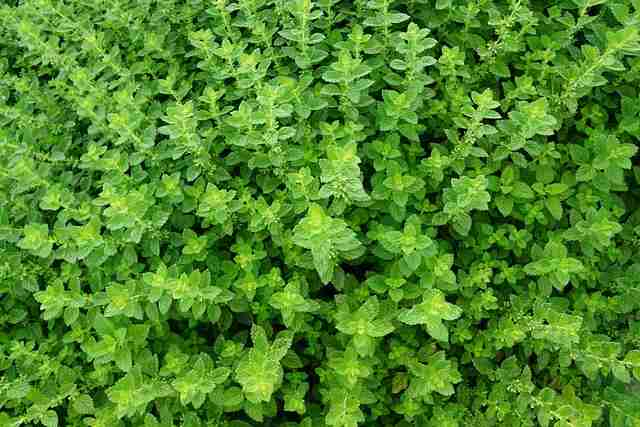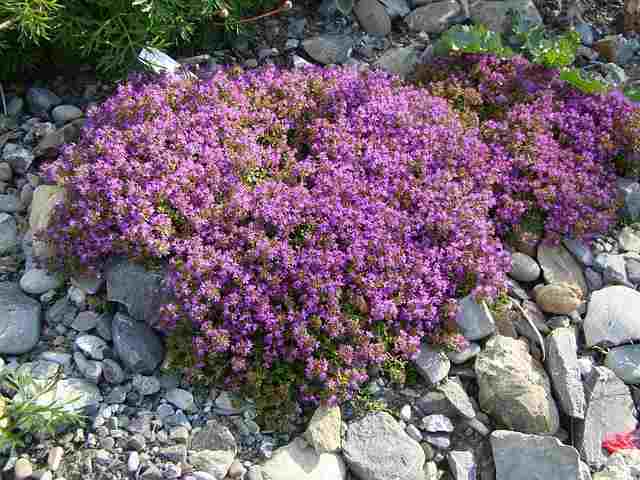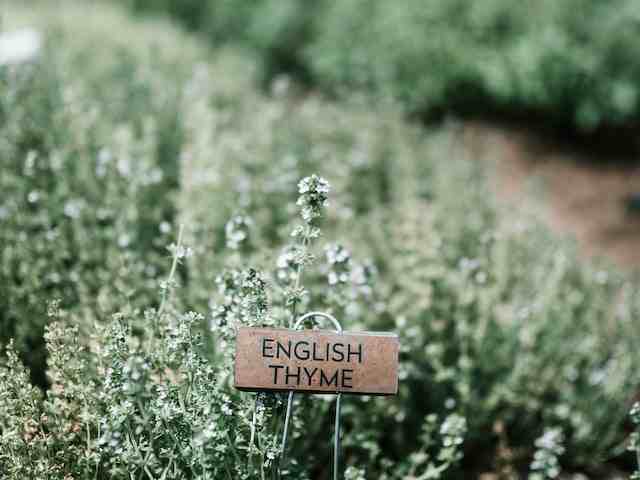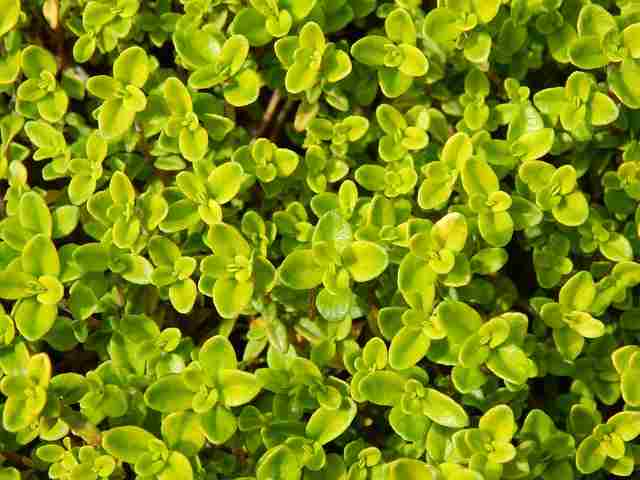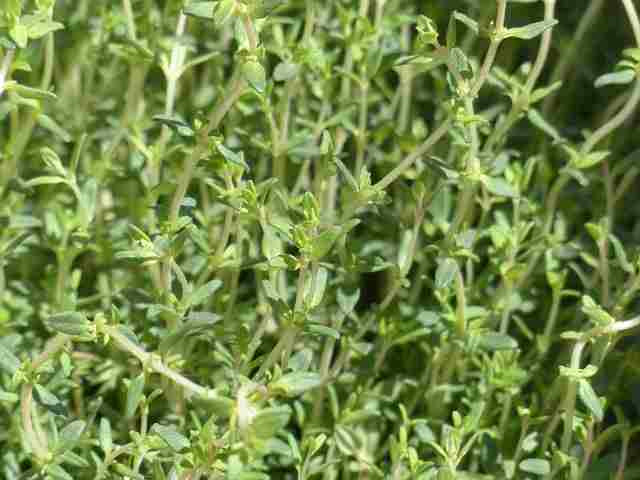What is Thyme Plant?
The thyme plant (Thymus vulgaris) is a fragrant herb that belongs to the mint family. It is a low-growing, perennial shrub that performs especially well in somewhat dry, sunny conditions.
This plant can reach a height of up to 12 inches and has woody stems with tiny leaves that are about a quarter inch long. The leaves are usually green or gray-green and are arranged in pairs along the stems. Its leaves remain evergreen, and most of the thyme varieties can even be harvested in winter in the zones where it is a perennial. It has pink, lavender, or white tubular flowers that appear in the spring and summer months and are well-liked by bees and other pollinators.
This plant is native to the Mediterranean region but can now be found in many parts of the world.
Thyme is a resilient plant that prefers full light and well-drained soil. It is easy to maintain and can be grown in containers or in the ground. It is a popular choice for herb gardens, as it attracts bees and other pollinators.
This plant has been used for centuries for culinary and medicinal purposes. Its leaves have a strong, earthy flavor and are widely used in cooking to add flavor to soups, sauces, stews, and meat dishes. It is a rich source of antioxidants, vitamins, and minerals and contains compounds with antibacterial, antifungal, and anti-inflammatory properties. Thus, this plant is used in natural remedies to treat respiratory infections, coughs, and digestive problems.
It is also a popular ingredient in herbal teas. Thyme oil, which is extracted from its leaves, is used in aromatherapy and is believed to have a calming effect on the mind and body.
Thyme Plant At A Glance
| Common name | Thyme |
| Scientific name | Thymus vulgaris |
| Family | Lamiaceae |
| Plant type | Perennial shrub |
| Native range | Mediterranean region |
| Invaded regions | North America, Australia, and New Zealand |
| Habitat | Full sun, well-drained soil |
| Growth rate | Moderate |
| Height | Up to 12 inches tall |
| Ultimate spread | Up to 24 inches (2ft) depending on the variety |
| Time to ultimate height | 3-4 years |
| Flower colors | Pink, lavender, or white |
| Leaves | Tiny, green, or gray-green, arranged in pairs |
| Flowers | Small, delicate, clustered at the ends of stems |
| Invasive potential | It can become invasive in some regions if not managed properly |
| Attract Pollinators | Pollinators such as bees and butterflies |
| Harvesting (leaf) | Leaves can be harvested year-round, but peak flavor is in summer |
| Uses | Culinary, medicinal, aromatherapy, and ornamental |
| Flavor | Strong, earthy |
| Soil pH | Acidic, neutral, alkaline |
| Propagation | Seed, stem cuttings |
| Bloom Time | Spring, Summer |
| Hardiness Zones | 5–9 (USDA) |
| Control methods | None needed for herb gardens, manual removal, mulching, or use of herbicides may be necessary for invasive populations |
How To Identify Thyme Plant?
Thyme plants are easy to recognize because of their distinctive characteristics. Here are some key characteristics to look for while identifying thyme:
1) Leaves
Its leaves are small, narrow, and arranged in pairs along the stems. These can be green or gray-green in color and are usually less than half an inch long.
2) Stems
Its stems are woody and can be either upright or spreading. These are usually 6 to 12 inches tall.
3) Flowers
Thyme flowers are small, delicate, and clustered at the ends of the stems. They can be pink, lavender, or white in color.
4) Aroma
Thyme plant has a strong, earthy aroma that is distinct and easily recognizable.
5) Taste
Its leaves have a strong, slightly bitter flavor that is often described as minty, lemony, or spicy.
6) Habitat
Thyme plants prefer full sun and well-drained soil. They are generally found in herb gardens, rock gardens, and along sunny pathways.
7) Growth Habit
Thyme plants are low-growing and spread slowly, forming small clumps. They can be pruned back to maintain a tidy appearance.
When identifying thyme plants, it’s important to note that there are many different varieties of thyme, each with its own unique characteristics. However, all these varieties share the features mentioned above, which can help you confidently identify them in the garden.
What Are The Different Types Of Thyme Plants?
There are several different types of thyme plants, each with its own unique characteristics. The following are some of the most common types of thyme:
1) Common Thyme (Thymus vulgaris)
It is also known as English or Garden thyme and is the most popular type of thyme used in cooking. It has a strong, earthy flavor and is often used in stews, soups, and roasted meats.
English thyme (Thymus vulgaris) has small, gray-green leaves and can grow 8-12 inches high, and has pale lilac or white flowers. It is a hardy plant that prefers full sun and well-drained soil.
2) Lemon Thyme
Lemon thyme is a variety of thyme that has a distinct lemon flavor and aroma. It is commonly used in marinades, sauces, and dressings. It pairs well with fish and poultry. It has small, green leaves with a slightly fuzzy texture. It is a compact plant that grows up to 6 inches tall and prefers full sun and well-drained soil.
3) French Thyme
French thyme has a sweeter flavor than English thyme and is often used in Mediterranean dishes. It has small, delicate leaves and a slightly pinkish tint to its green color. It can reach a height of one foot (12 inches) with a more compact growing habit than common thyme. It prefers full sun and well-drained soil.
4) Caraway Thyme
Caraway thyme has a flavor similar to caraway seeds and is often used in German cuisine. It is a low-growing (6 inches) variety with narrow green leaves and light pink flowers. It grows well in full sun with well-drained soil. It pairs well with pork, sauerkraut, and potatoes.
5) Woolly Thyme
Woolly thyme is a type of thyme that is often used as a ground cover in landscaping. It has small, fuzzy leaves and small pink flowers. It has a milder flavor than other types of thyme and is not typically used in cooking. It’s a flat creeping variety and usually doesn’t grow above 3 inches tall.
6) Silver Thyme
Silver thyme has silvery-gray leaves that add an ornamental touch to gardens and borders. It has a mild, lemony flavor and is often used in Mediterranean cuisine. It can reach a height of one foot and prefers full sun and well-drained soil.
7) Creeping Thyme
Creeping thyme is a type of thyme that spreads rapidly and forms a dense ground cover. It has small, green leaves and a strong, minty flavor. It grows up to a few inches tall and is often used in Mediterranean cuisine. It thrives in full sun and well-drained soil.
8) Elfin Thyme
Elfin thyme is a miniature variety of thyme that grows only a few inches tall. It has tiny, green leaves and a strong, spicy flavor. It is often used in small pots or as a ground cover in rock gardens. It prefers full sun and well-drained soil.
How to Grow Thyme Plant?
Below here are some tips on how to grow thyme (thymus):
1) Choose the Right Location
Thyme thrives in full sun and well-drained soil. So, you should choose a spot in your garden or container that receives at least 6 hours of direct sunlight per day.
2) Prepare the Soil
Thyme prefers slightly alkaline soil with a pH between 7.0 and 8.0. If your soil is too acidic, you can add some lime to raise the pH.
It also likes soil that is well-drained, so if your soil is heavy, you can amend it with some sand or gravel to improve drainage.
3) Start with Seedlings or Cuttings
Thyme can be grown from seeds, but it may not germinate as quickly as seedlings or cuttings. It is often easier to start with seedlings or cuttings from an established plant.
You can find thyme seedlings or cuttings at your local nursery or garden center.
4) Plant the Thyme
Plant the seedlings or cuttings in the prepared soil, spacing them about 6 to 12 inches apart. Water them well after planting.
5) Water Regularly
Thyme does not like to be over-watered, so be careful not to water it too often. Allow the soil to dry out slightly between waterings. Avoid getting water on the foliage because this might cause fungus problems.
6) Fertilize Sparingly
Thyme doesn’t require a lot of fertilizer, so fertilize carefully. You can feed it once or twice a year with a balanced fertilizer, or you can use compost or aged manure as a natural fertilizer.
7) Prune Regularly
Regular pruning is beneficial for thyme because it promotes bushy growth and prevents woody stems. Trim back the plants by about one-third in the spring and again in the fall.
By following these tips, you can grow a healthy and productive thyme plant. It is a hardy and versatile herb that can be used in a variety of dishes, from soups and stews to marinades and dressings. With a little care and attention, you can enjoy fresh thyme from your garden or container all year round.
What Are The Benefits of Thyme Plant?
Thyme is a multipurpose herb with several possible health benefits. Here are some of the benefits of the thyme plant:
1) Thyme Has Anti-inflammatory Properties
It contains compounds such as rosmarinic acid and thymol that have anti-inflammatory properties. These compounds may help to reduce inflammation in the body, which may aid in the prevention of chronic diseases such as heart disease, diabetes, and cancer.
2) It Has Antimicrobial Properties
This plant has antimicrobial properties that make it effective for treating infections. Thyme oil has been shown to be effective against a wide range of bacteria, including Staphylococcus aureus and Escherichia coli.
3) Benefits of Thyme Plant For Digestive Health
Thyme may aid digestion by boosting the synthesis of digestive enzymes. It may also help to relieve bloating, gas, and other digestive issues.
4) Benefits of Thyme Plant For Respiratory Health
This plant has been used for centuries to treat respiratory conditions such as cough, bronchitis, and asthma. It may help to relieve congestion and soothe inflammation in the airways.
5) It Boosts the Immune System
Thyme contains compounds such as carvacrol and thymol that have been shown to have immune-boosting properties. These compounds may help to stimulate the production of white blood cells, which can help to fight off infections.
6) It Has Antioxidant Properties
Thyme contains high levels of antioxidants, which can help to protect the body from free radical damage. Free radicals are molecules that can cause cell damage and contribute to the development of chronic diseases.
7) Benefits of Thyme Plant For Skin Health
Thyme has anti-inflammatory and antibacterial qualities that may be beneficial to the skin. Thyme oil has been used to treat acne, eczema, and other skin conditions.
Overall, the thyme plant is a nutrient-dense herb that offers many potential health benefits. It can be used in a variety of ways, including in cooking, as tea, or in topical preparations. But, it’s important to note that this plant is not a substitute for medical treatment, and you should always consult with your healthcare provider before using it for a health condition.
How to Take Care of Thyme Plant?
Here are some tips on how to take care of thyme plants:
Watering
Thyme plants prefer well-drained soil and don’t need to be watered frequently. You should allow the top inch of soil to dry out before watering. It’s important to avoid keeping the soil too wet because overwatering can lead to root rot and other problems.
Soil
Thyme grows best on slightly alkaline soil with a pH between 7.0 and 8.0. You may check the pH of your soil using a soil test kit and adjust it as necessary by adding lime or sulfur. Thyme also benefits from well-drained soil that is rich in organic matter.
Sunlight
Thyme needs a lot of sunlight to thrive. Make sure to plant it in a location that receives at least 6 hours of direct sunlight per day.
Fertilizer
Thyme does not require a lot of fertilizer; however, a balanced fertilizer can be applied once or twice a year to boost its growth. You can also use compost or aged manure as a natural fertilizer.
Pruning
Regular pruning helps to keep thyme plants healthy and prevent them from becoming too woody. You should trim back the plants by about one-third in the spring and again in the fall.
Harvesting
Thyme can be harvested throughout the growing season. You can harvest the leaves as needed by snipping them off with scissors. But you should avoid harvesting more than one-third of the plant at a time, as this can cause stress to the plant.
Pest and Disease Control
These plants are generally resistant to pests and diseases, but you should still keep an eye out for problems such as spider mites, aphids, and root rot. If you notice any signs of pests or disease, treat them as soon as possible with organic methods like neem oil or insecticidal soap.
You can maintain your thyme plants healthy and productive for years by following these tips.
How To Manage Pests and Diseases of Thyme Plant?
Thyme is a hardy and relatively disease-resistant plant. However, it can be susceptible to some pests and diseases. Below here are some tips for managing pests and diseases of thyme plant:
1) Aphids
Aphids are small, soft-bodied insects that feed on the sap of thyme plants, causing leaves to yellow and wilt. To control aphids, you can
- Spray the plant with a strong stream of water,
- Use insecticidal soap or neem oil, or
- Release natural predators such as ladybugs or lacewings.
2) Spider Mites
Spider mites are small arachnids that can cause leaves to turn yellow and fall off. To control spider mites, you can try spraying the plant with a strong stream of water, releasing natural predators such as predatory mites or ladybugs, or using insecticidal soap or neem oil.
3) Root Rot
Root rot is a fungal disease that can occur when the soil is too moist. To prevent root rot, keep the soil well-drained and avoid overwatering the plant. If root rot does occur, the affected plant may need to be removed and disposed of.
4) Powdery Mildew
Powdery mildew is a fungal disease that can cause a white, powdery coating on the leaves of thyme plants. To prevent powdery mildew, make sure the plant has proper air circulation and avoid overhead watering. If powdery mildew does occur, you can treat it by spraying the plant with a solution of baking soda and water or using a fungicidal spray.
5) Leaf Spot
Leaf spot is a fungal disease that can cause brown or black spots on the leaves of thyme plants.
To prevent a leaf spot, make sure the plant has proper air circulation and avoid overhead watering. If a leaf spot does occur, you may need to remove and dispose of the affected leaves.
In general, the best way to prevent pests and diseases in thyme plants is to provide them with appropriate growing conditions. This includes well-drained soil, adequate water, and proper sunlight. If you do notice signs of pests or diseases, try to identify the problem as soon as possible and take measures to control it before it spreads.
How to Grow Thyme Plants Indoors?
To grow thyme indoors, follow these steps:
1) Choose a Container
Select a container with good drainage holes and a diameter of at least 8-10 inches.
2) Prepare the Soil
Use well-draining soil with a pH of 6.0-8.0. You can mix equal parts of potting soil, sand, and perlite to create a suitable growing medium.
3) Plant the Seeds or Cuttings
Sow the seeds or plant the cuttings about ¼ inches deep into the soil. Water the soil gently.
4) Place the Container in a Sunny Spot
This plant requires at least six hours of sunlight daily to grow and develop properly. Thus, if you are growing thyme indoors in a container, make sure it gets at least six hours of direct sunlight every day. This can be achieved by placing the container near a window that gets enough sunlight or by using grow lights to give the plant enough light.
5) Water and Fertilize the Soil
Water the soil regularly, but make sure it doesn’t become waterlogged. Thyme prefers slightly dry soil. Fertilize the plant every two to three weeks using a balanced fertilizer.
6) Prune Regularly
Thyme grows well when pruned regularly, so trim it back to prevent legginess and encourage bushy growth. You can also harvest the leaves as needed.
7) Watch for Pests and Diseases
Indoor thyme plants may be susceptible to spider mites, aphids, and fungal diseases. So, regularly check the plants, and address any issues right away.
By following these steps, you can successfully grow thyme indoors and enjoy fresh herbs year-round.
Conclusion
The thyme plant is a versatile and beneficial herb that can be grown easily in various kinds of conditions. It is a hardy plant that is relatively resistant to pests and diseases, making it a low-maintenance option for gardeners. This plant has been used medicinally for centuries and is well known for its antibacterial, antifungal, and antioxidant properties. It can be used fresh or dried in a number of dishes and is a popular ingredient in Mediterranean and Middle Eastern cuisine. Also, it is commonly used in aromatherapy and can be a useful natural remedy for respiratory problems and stress. Thyme’s virtues make it a great addition to your herb garden or kitchen.
Frequently Asked Questions About Thyme Plant
How often should I water my thyme plants?
These plants prefer well-drained soil and should not be overwatered. So, water them deeply once a week, or whenever the top inch of soil feels dry to the touch.
How much sunlight do thyme plants need?
These plants thrive in full sun, so it’s best to plant them in a spot that receives at least 6 hours of direct sunlight per day.
Can You Eat Thyme?
Yes, thyme is an edible herb that is commonly used in cooking. It has a pleasant, earthy flavor that can enhance the taste of many dishes, including soups, stews, roasted meats, and vegetables.
Its leaves can be used fresh or dried and can be added to dishes whole or chopped finely. In addition to its culinary uses, this plant also has many possible health benefits, including antioxidant, antibacterial, and anti-inflammatory properties.
Can you grow thyme plants indoors?
Yes, you may grow thyme plants indoors in a sunny place near a window. Make sure to choose a pot with good drainage and use a well-draining potting mix.
How do I harvest thyme?
To harvest thyme, simply snip off sprigs of the plant as needed. You can also harvest the entire plant by cutting it back to about 3 inches above the soil level.
What are some common uses for thyme?
Thyme is a versatile herb that can be used in a variety of dishes, including soups, roasted meats, stews, and vegetables. It is also commonly used in Mediterranean and Middle Eastern cuisine. It is also useful in aromatherapy and as a natural remedy for respiratory problems and stress.
How do I propagate thyme?
Thyme can be propagated by taking stem cuttings in the spring or fall. Simply cut a 4-6 inch stem from a healthy plant, remove the lower leaves, and place the cutting in a pot with moist potting soil. Keep the soil moist and the cutting in a warm, bright location until it roots.
Are there any health risks associated with thyme?
This plant is generally considered safe when used in culinary amounts. However, some people may be allergic to thyme, and high doses of its oil can be toxic. If you have any concerns, it’s best to consult your doctor before using this herb for medicinal purposes.
Can Dogs Eat Thyme?
While thyme is generally safe for dogs to consume in small amounts, it is not recommended that they consume it in excessive quantities or on a regular basis. Thyme contains essential oils that, if consumed in excess, can cause digestive upset in dogs, and can also irritate their skin if they come into contact with it.
If you wish to use this plant as a natural remedy for your dog’s health issues, it is important to consult with a veterinarian first to determine the proper dosage and ensure that it is safe for your dog to consume.
Furthermore, if you suspect that your dog has consumed a large amount of thyme or is exhibiting any indications of sickness as a result of swallowing this plant, you should consult a veterinarian immediately.
Can You Eat Thyme Leaves?
Yes, its leaves are edible and are commonly used in cooking.
Is thyme native to the US?
No, this plant is not native to the United States. It is native to the Mediterranean region, including parts of southern Europe, western Asia, and North Africa. However, it has been introduced and naturalized in many parts of the world, including the United States.
What is another name for the thyme plant?
This plant is also known by its scientific name, Thymus vulgaris. It is also known by its common names, such as garden thyme, common thyme, or English thyme. Additionally, there are many varieties of thyme with their own specific names, such as lemon thyme, orange thyme, and caraway thyme, among others.
Is any part of thyme poisonous?
No, none of the parts of thyme is considered poisonous to humans or animals when consumed in moderate amounts. In fact, it has been used for centuries as a culinary herb and medicinal plant.
However, it’s important to note that some people may be allergic to this plant, particularly if they are sensitive to other plants in the mint family. Additionally, while thyme is safe to consume in small quantities, consuming large amounts of this plant or its oil may cause digestive upset.
Is rosemary the same as thyme?
No, rosemary and thyme are two different plants with their own distinct characteristics. While both herbs are often used in cooking, they have different flavor profiles and physical characteristics.
Rosemary (Rosmarinus officinalis) is an evergreen perennial herb with needle-like leaves that are grayish-green in color. Its leaves have a distinct pine-like aroma and a strong, slightly bitter flavor. Rosemary is often used to flavor meats, stews, and sauces.
Thyme (Thymus vulgaris) is also an evergreen perennial herb, but its leaves are small and oval-shaped with a gray-green color. It has a warm, herbal flavor with hints of mint and citrus, and is commonly used in Mediterranean and Middle Eastern cuisine, as well as in herbal remedies.
While rosemary and thyme are different plants, they can complement each other well in certain dishes, such as roasted meats and vegetables.
Is thyme plant easy to grow?
Yes, the thyme plant is generally considered an easy herb to grow, especially in regions with a Mediterranean climate. It is a hardy perennial plant that prefers well-drained soil, plenty of sunlight, and moderate water. It is drought-tolerant and can withstand hot, dry conditions, making it a great choice for low-maintenance gardens.
Does thyme grow fast?
Thyme is a relatively slow-growing plant, especially compared to other herbs like basil or parsley. It can take several months for this plant to reach full maturity, but once established, it can continue to grow and thrive for many years. Although this plant grows slowly, it can still benefit from occasional pruning to promote new growth and prevent the plant from becoming too woody.
It’s important to note that different varieties of thyme may have different growth rates. For example, creeping thyme (Thymus serpyllum) may grow more quickly and spread more aggressively than other thyme varieties.
References:
1) Thymus (Thyme)
https://plants.ces.ncsu.edu/plants/thymus/
2) Thyme | Diseases and Pests, Description, Uses, Propagation
https://plantvillage.psu.edu/topics/thyme/infos
3) A Focused Insight into Thyme: Biological, Chemical, and Therapeutic Properties of an Indigenous Mediterranean Herb
https://www.ncbi.nlm.nih.gov/pmc/articles/PMC9147557/
Recommended Articles:
1) How To Grow Purslane Plant & Benefits Of Purslane
